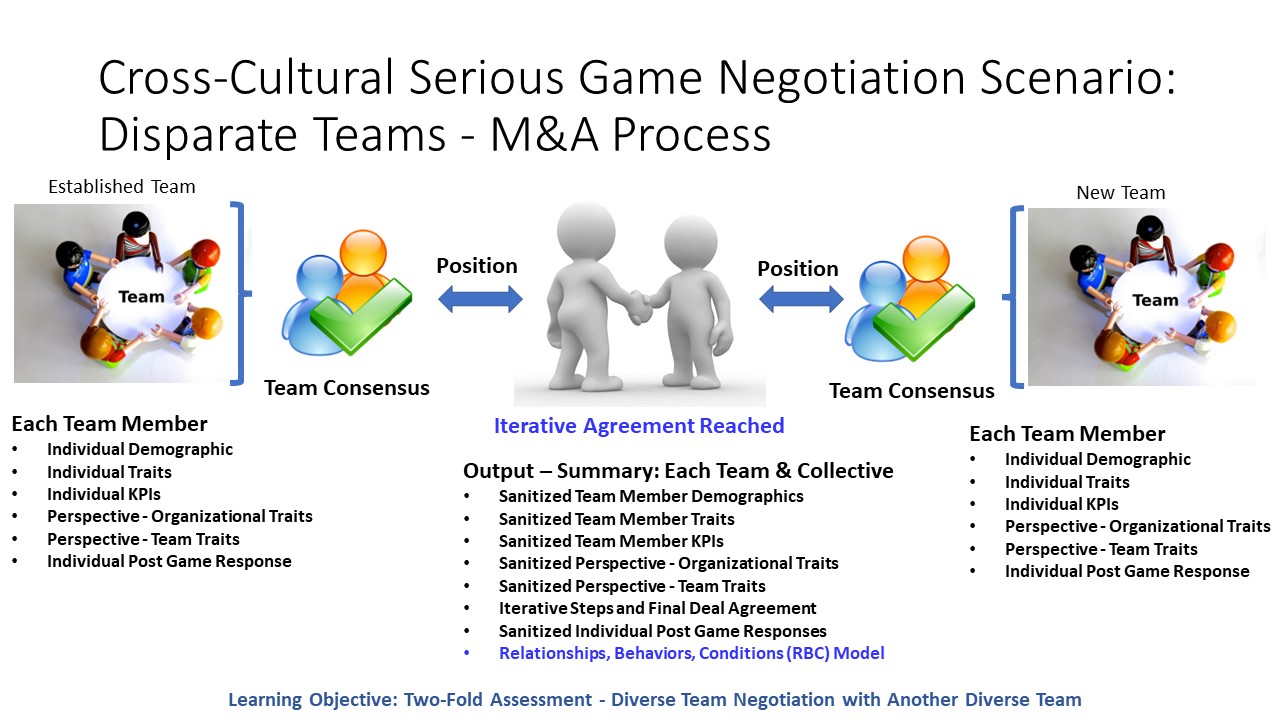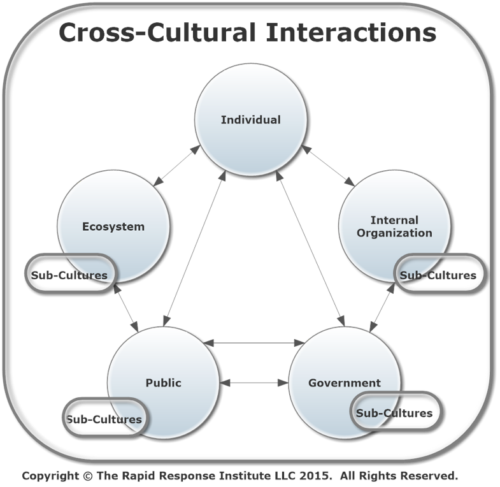Why are Diversity, Equity and Inclusion (DEI) initiatives failing?
In previous blogs, we have addressed the challenges of turning organizational initiatives into culture. Moreover, we discussed DEI and the shortcomings of those institutional efforts as well as broached the construct of Teams incorporating DEI.
In this edition, we will expand on those subjects and develop a realistic approach toward team building that fully incorporates the precepts of DEI in a realistic manner.
Five Elements
As depicted in the title graphic, organizational cross-cultural interactions incorporate one or more of these dynamic components.
- The Individual defined as a single human being or perhaps other entity with whom others collaborate
- The Internal Organization defined the (legal) entity one or more individuals associate with on a daily basis
- The Government defined elected officials as all levels of the Federal, State and Local governance bodies including any and all regulatory bodies or other agencies
- The Public defined as communities and other interest groups including the media as well as its social aspect
- The Ecosystem defined as the broad group of constituents which includes clients/customers, the supply chain as well a professional services engaged with the organization
Note that sub-cultures abound across the four elements other than the individual. Four example, a taskforce or team may be formed to implement a global IT system. In this case, the team may be composed of individual from several countries as well as Internal and External IT professionals.. In this case this would be an Internal Organization Sub-Culture. Another Sub-Culture might be the NYC office with a distinct local flavor.
These five elements are built upon a pretty straightforward peer reviewed behavioral framework.
The RBC Framework
The Relationships, Behaviors, Conditions (RBC) Framework was originally developed to address the International Cross-Cultural Negotiation process. Briefly, this is a dynamic model with emphasis on interactive relationships resulting from multiple levels of behavioral analysis.
- Relationship dynamics are the focus including, commonality of interest, trust, balance of power and conflict intensity
- Behaviors are defined from a broad multi-dimensional perspective and includes intentional as well as unintentional
- Conditions include circumstances, capabilities and competencies of the parties, cultural considerations and the environment
For almost 30 years we have been expanding and enhancing this model. It is now used for ANY human interaction as well as Machine-Human interfaces, i.e. Artificial Intelligence (AI).
Finally, we see this construct as very fabric of the modern organizational Team.
What is a Team?
By one definition a team is, “a group of people who perform interdependent tasks to work toward accomplishing a common mission or specific objective.” As a general rule, teams are composed of individuals either appointed politically or assigned based on talent and expertise.
When politically assigned to meet somewhat arbitrary DEI driven goals, one can expect such teams to fail–often visibly as a great calamity. Thus driving survivors and others away from new similar teams.
Thirty years ago this pundit witnessed the implementation of the then new Enterprise Resource Planning (ERP) IT systems. Most were late and way over budget. They rightfully earned the badge of ‘Career Killer.’ Not surprisingly, no one wanted to be assigned to this type of project. Most consulting firms implementing these systems wanted someone with knowledge of the business on the project as well as IT professionals. Key personnel could not be spared from operations and often junior or less qualified IT employees were assigned. Needless to say, some level of disappointing performance was almost certainty guaranteed. These were diverse teams composed of third party consultants, operations and finance individuals as well as internal IT people.
These were not effective teams. Many were even destructive.
Creating an Effective Team
A Google search of the term ‘teambuilding’ generates 160 million hits. It is a well documented process, so why are successful teams so elusive?
Most critical teams undergo a selection process as described previously with some training. The project commences often with significant time and budget constraints. In many cases the team malfunctions from the ‘get go.’ So why would DEI efforts end differently? One suspects most do not.
When students participate in active learning, they learn more. This has been known for some time. Sadly, and often in the DEI space, workshops do not address the actual issue organizations are facing. However, their is a more successful learning model.
Organizational Team Truths
As noted above, organizations build teams to solve critical problems. They do not group Individuals by category or classification. High Performance Teams are anything but homogeneous.
- First, teams must form. A mission/goal(s), set of deliverables, budget (if appropriate) and time frame must be developed and agreed to by management.
- Then, members must get to know each other, roles and tasks assigned, etc.
- What does success look like? Metrics established.
Most teams do not live in a vacuum so if they are to collaborate with one or more other teams (Internal or Ecosystem) this process is extended. In many cases such as a merger or safety initiative, Government and even the Public will need to be engaged.
Now a collaborative negotiation between ‘semi-independent’ parties to arrive at mutual success. This is generally an iterative process.
To create an active learning environment to cost effectively train new teams in a timely manner, simulations and game theory play a critical role.
Moreover, to maximize effectiveness, such a Serious Game must be based on a Behavioral Science Framework. This type of Team-to-Team interaction is available using video conferencing to engage teams meaningful training using ‘real world’ scenarios.
The graphic below depicts this process. Readers will also note a number of metrics will provide feedback to students to further enhance their learning experience.

DEI ROI
One comment routinely heard regarding DEI is the lack of return on the effort. Not necessarily monetary return but the learning does not ‘stick.’
Benjamin Franklin is credited with the quotation, “Tell me and I forget, teach me and I may remember, involve me and I learn.” When these teams are composed of a variety of Individuals working to solve realistic collective problems the result better reflects actual organization life. All aspects of DEI can be incorporated into the game scenario. All students benefit from a much better learning experience and by extension the organizations they represent.
The following short video is aligned with this discussion. Well worth the few minutes it will take to watch it.
Realizing DEI
Simon makes the point that strong Organizations are more diverse. In this pundit’s long international career, I support his contention. Moreover, true strength from a diverse Organization and its Ecosystem cannot be reached if individuals are not treated fairly and included in the process. The serious game scenarios help assure all individuals participate.
Want some help upping your DEI game? Contact Us.
For More Information
Please note, RRI does not endorse or advocate the links to any third-party materials herein. They are provided for education and entertainment only.
The author’s credentials in this field are available on his LinkedIn page. Moreover, Dr. Shemwell is a coauthor for an in press book (to be released in Spring 2023) titled, “Smart Manufacturing: Integrating Transformational Technologies for Competitiveness and Sustainability.” His focus is on Operational Technologies.
“People fail to get along because they fear each other; they fear each other because they don’t know each other; they don’t know each other because they have not communicated with each other.” (Martin Luther King speech at Cornell College, 1962). For more information on Cross Cultural Engagement, check out our Cross Cultural Serious Game. You can contact this author as well.
The video by Simon Sinek is from YouTube.
For more details regarding climate change models, check out Bjorn Lomborg ands his latest book, False Alarm: How Climate Change Panic Costs Us Trillions, Hurts the Poor, and Fails to Fix the Planet.
Regarding the economics of Climate Change, check out our recent blog, Crippling Green.
For those start-up firms addressing energy (including renewables) challenges, the author can put you in touch with Global Energy Mentors which provide no-cost mentoring services from energy experts. If interested, check it out and give me a shout.

